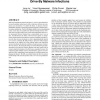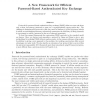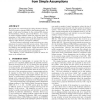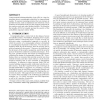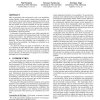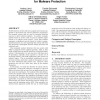CCS
2010
ACM
14 years 20 days ago
2010
ACM
Web-based surreptitious malware infections (i.e., drive-by downloads) have become the primary method used to deliver malicious software onto computers across the Internet. To addr...
CCS
2010
ACM
14 years 20 days ago
2010
ACM
Protocols for password-based authenticated key exchange (PAKE) allow two users who share only a short, low-entropy password to agree on a cryptographically strong session key. The...
CCS
2010
ACM
14 years 20 days ago
2010
ACM
Decentralized information flow control (DIFC) operating systems provide applications with mechanisms for enforcing information-flow policies for their data. However, significant o...
CCS
2010
ACM
14 years 20 days ago
2010
ACM
Cross-origin CSS attacks use style sheet import to steal confidential information from a victim website, hijacking a user's existing authenticated session; existing XSS defen...
CCS
2010
ACM
14 years 20 days ago
2010
ACM
Congestion control algorithms seek to optimally utilize network resources by allocating a certain rate for each user. However, malicious clients can disregard the congestion contr...
CCS
2010
ACM
14 years 20 days ago
2010
ACM
We provide new constructions of Leakage-Resilient IdentityBased Encryption systems (IBE) in the Standard model. We apply a hash proof technique in the existing IBE schemes of Bone...
CCS
2010
ACM
14 years 20 days ago
2010
ACM
Computational Indistinguishability Logic (CIL) is a logic for reasoning about cryptographic primitives in computational models. It captures reasoning patterns that are common in p...
CCS
2010
ACM
14 years 20 days ago
2010
ACM
Many cryptographic tasks and protocols, such as non-repudiation, contract-signing, voting, auction, identity-based encryption, and certain forms of secure multi-party computation,...
CCS
2010
ACM
14 years 20 days ago
2010
ACM
Heap-based attacks depend on a combination of memory management errors and an exploitable memory allocator. We analyze a range of widely-deployed memory allocators, including thos...
CCS
2010
ACM
14 years 20 days ago
2010
ACM
Models based on system calls are a popular and common approach to characterize the run-time behavior of programs. For example, system calls are used by intrusion detection systems...
